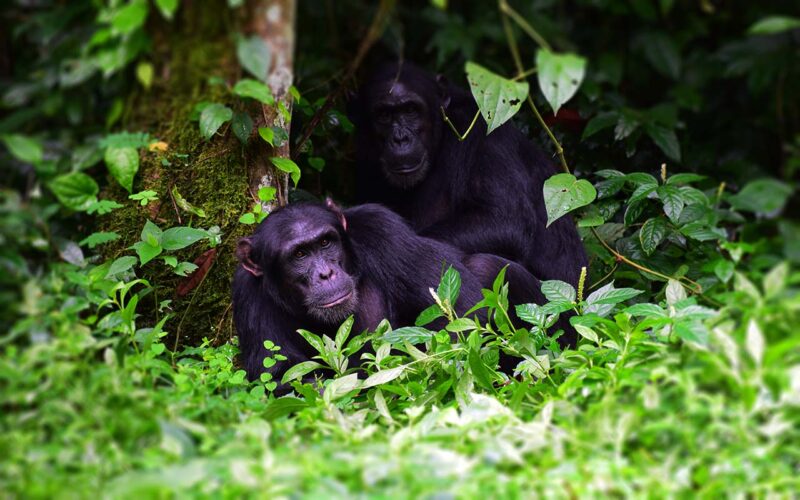Chimpanzee trekking in Uganda is one of the major highlights on any Uganda safari. A trek experience brings you up-close to this man’s closest relative ape that share up to 98.7% of human DNA, watching its social structures and similar-like behavior in its native rainforest home. Here is what you need to know as you plan for this epic safari expereince.
About the Chimpanzee
Uganda’s rainforests host the largest populations of the Common Chimpanzee outside Congo forest where this population is often treated as a full species now named the Eastern Common Chimpanzee (Pan. t. schweinfurthi). Chimpanzee are charismatic species, agile and the most intelligent of the big apes that exhibit recognizable human-like traits like facial expressions and complex social structures. Their intelligence has been exhibited in tool manipulation and strategy in their day to day lifestyle. Chimpanzee occur in large communities numbering over 150 individuals led by a dominant male at the helm, assisted by a “gang” of subordinate males. A typical day in this complex community, starts with a male-only troop setting off to patrol, defend and protect the home range and raiding outside territories while the female and young spread out in individual family units to feed within the range in protection of the dominant male.
A Typical Day on a Chimp Trekking Experience
A chimpanzee trekking day begins with you the visitor checking-in at the park’s visitors center on a the booked trek day as indicated on your permit. A briefing session follows on to prepare you for the activity and thereafter ranger guides will set you in an 8-person groups to be led out towards the chimpanzee troop home range. On locating the chimpanzee, you will get to spend one hour with the troops. Chimpanzee trekking experience is scheduled differently from each location but at Kibale NP, treks leave every morning and afternoon schedules, stretching anywhere between 3-5 hrs.

What you need to know about Chimpanzee trekking expereince in Uganda
The difference between Ordinary Chimpanzee and Habituation Trekking Experience
Chimpanzee trekking is offered in two distinct experience programs offering different duration with the chimpanzee.
An Ordinary Chimpanzee tracking experience offers visitors one-hour interaction with the species while the trek can last up 4hrs. The longer and richer habitation experience (CHEX), offers an exclusive time with chimpanzee where you trek with research guides following a semi-habituated chimpanzee family. The day begins very early (6am) targeting to find the chimps where they nested and following on as they forage. This offers you rare insights of the chimpanzee before fully getting used to human presence.
Permit Cost: Tracking permits for the ordinary tracking experience vary with each chimpanzee trek site but at Uganda’s primate capital of Kibale NP, ordinary costs 250 USD pp while habituation costs 300 USD per person.
Where to Trek Chimpanzee in Uganda
- Kibale National Park is undoubtedly the region’s premier destination for chimpanzee trekking experience. The park boasts of an incredible ranger guide teams with unmatched combined experience in conservation and habituation of chimpanzee. In the vast Kibale NP, communities of habituated Chimpanzee are tracked every morning and afternoon where ranger guides lead out groups to different feeding grounds of these species and get to spend an hour watching and learning about them. Chimpanzee Habituation Experience is available for those who seek more insights into these species’ lifestyles and have time on their hands. The activity takes almost a full day.
- Kyambura Gorge in Queen Elizabeth National Park. The underground forest Kyambura Gorge set in the savanna plains of Queen Elizabeth National Park is the best place to encounter chimps in the wild. Covered by a typical rain-forest, Kyambura gorge lies 100m below the surrounding savanna woodlands, extending 40 km long and up to a kilometer wide protecting a community of chimpanzee and several primates. Daily chimpanzee trekking experience begins from the Fig-tree camp on the edges of the gorge to follow various trails in the underground forest where duration may last between 4-6hrs.
- Kalinzu Forest sits on the eastern edges of Queen Elizabeth NP protecting large communities of chimps where only one is available for trek activities. Kalinzu forest boasts an exclusive and rewarding trek experience owing to low permit fees and low numbers of tourists. Permit fees costs 120 USD pp for foreign visitors. Other primates include; Blue and Red-tailed Monkeys and the shy L’hoest Monkey. This Medium Altitude Forests is an extension of the greater Imaramagambo Forest and hosts several same flora and fauna. Activities start in mornings and afternoons where duration lasts up to 4 hrs.
- Ngamba Island is located just 30km off Entebbe landing site where rescued Chimpanzee from pet traders are given a new life and restored. Established in 1998 with only 19 orphaned individuals, now the numbers have really flourished in this natural forested island home. The chimps are regularly monitored and occasional come over the camps for fresh fruits and play. Activities on the island include a behind-the-scenes tour with staff or just a nature walk on the sand beaches.
- Kaniyo Pabidi Forest is part of the Budongo forest block that lies within the greater Murchison Falls Conservation Area. The trek office is only 8 km from the main entry gate of Kicumbanyobo
What is the age limit for Chimp trekking?
The minimum age limit for chimpanzee tracking is 12 years.
Health
It is important to note that anyone with communicable diseases like cough and flu will NOT be allowed to trek with chimps in fear to pass on the diseases to these primates.
Packing List for Chimpanzee trekking
While planning a chimpanzee trekking tour, along with your camera gear remember to pack;
- Good and sturdy walking boots along with long stocks
- Long trousers and long sleeved shirts preferable in nature blending colors (strictly not military colors)
- Poncho or rain jackets
- Binoculars
- Hand gloves
